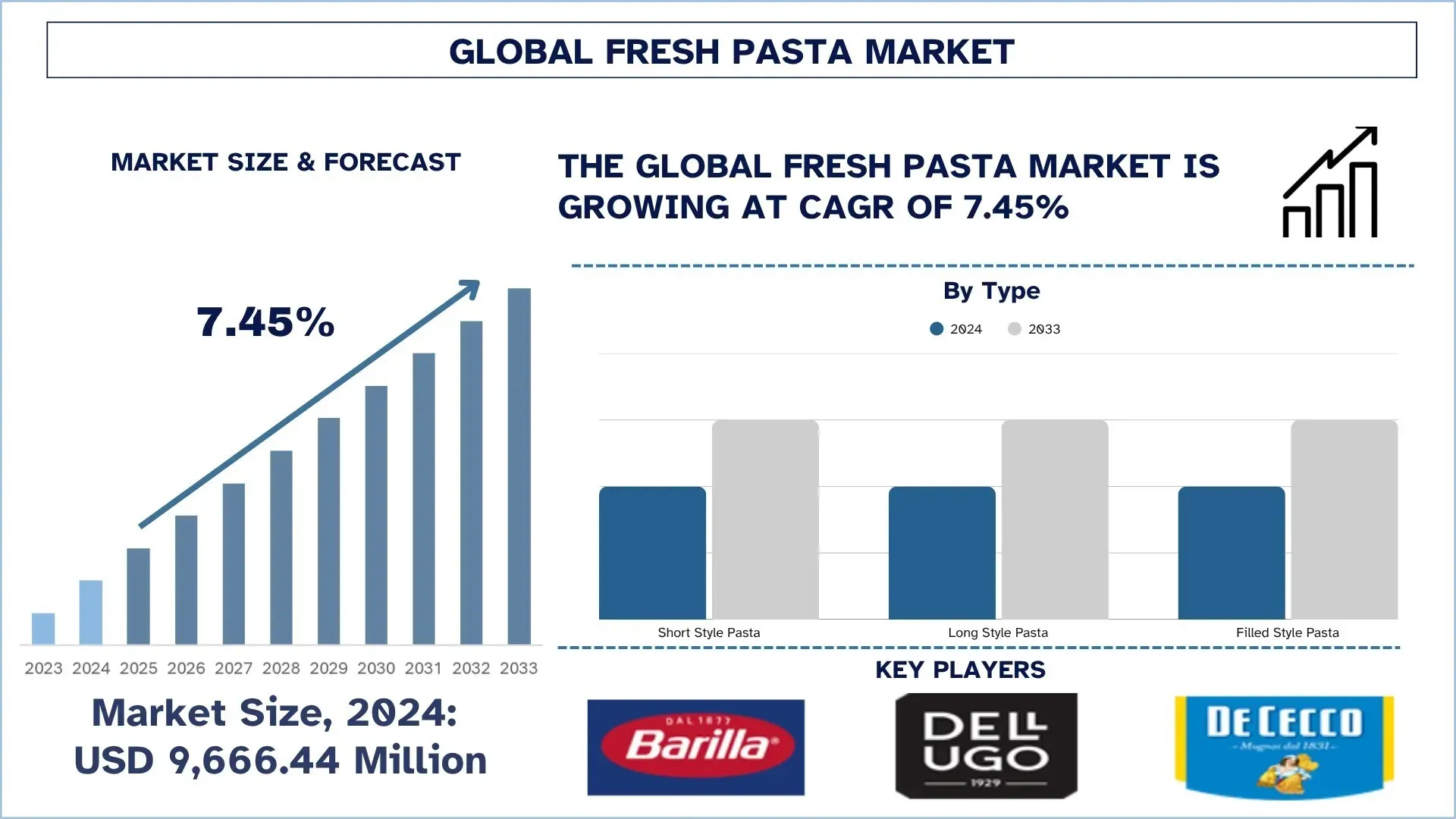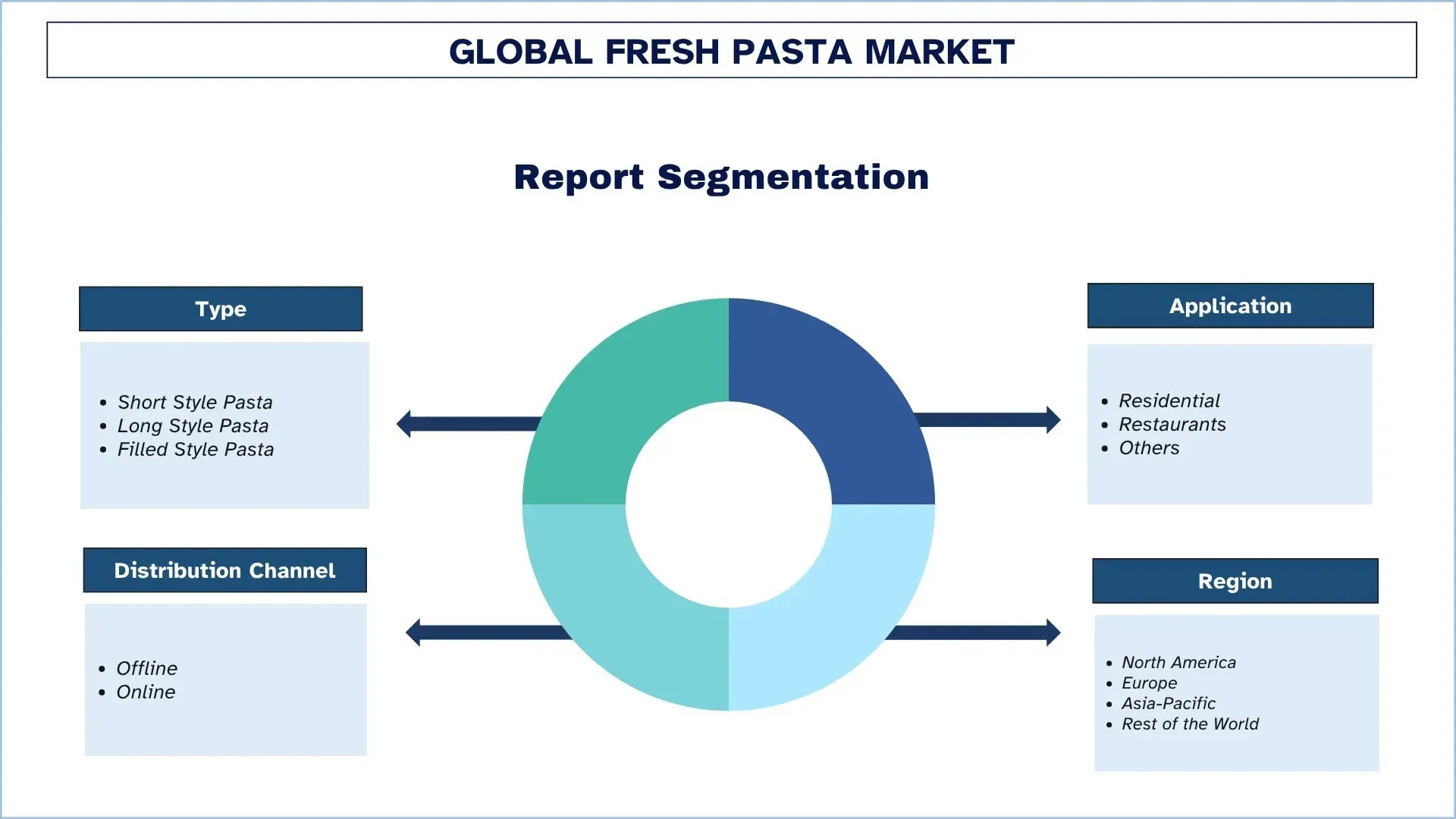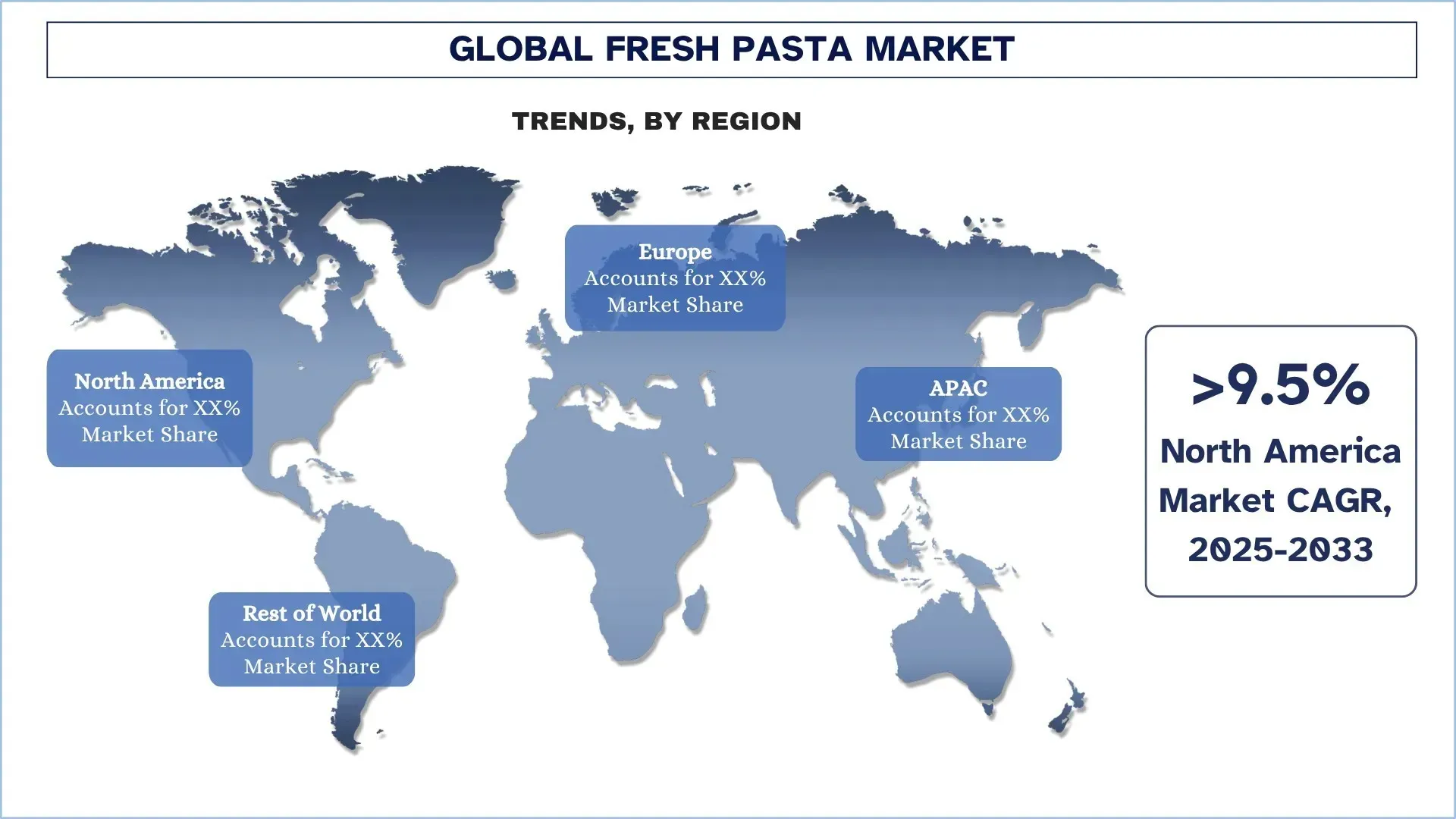- Home
- About Us
- Industry
- Services
- Reading
- Contact Us
Fresh Pasta Market: Current Analysis and Forecast (2025-2033)
Emphasis on Type (Short Style Pasta, Long Style Pasta, and Filled Style Pasta); Distribution Channel (Offline and Online); Application (Residential, Restaurants, and Others); and Region/Country

Global Fresh Pasta Market Size & Forecast
The global Fresh Pasta Market was valued at USD 9,666.44 million in 2024 and is expected to grow at a strong CAGR of around 7.45% during the forecast period (2025-2033F), driven by the rising consumer demand for convenient, healthy, and premium food options, along with the globalization of culinary tastes and increased availability through retail and online channels.
Fresh Pasta Market Analysis
Pasta is widely enjoyed globally because of its versatility, quick cooking, and compatibility with many ingredients. Fresh pasta is especially favored due to its tender texture, rich taste, and quicker cook time compared to dried types. The market offers a variety of pasta styles, including short pasta, long pasta, filled options like ravioli and tortellini, and specialty gluten-free or plant-based choices. The fresh pasta market is evolving steadily due to a shift in consumer lifestyles and preferences. Nowadays, consumers demand convenient, ready-to-cook meals without compromising on quality or flavor. Trends such as the growth of gourmet food, plant-based options, and organic ingredients are widening product ranges and promoting innovation among top brands. Furthermore, fresh pasta’s quality and versatility attract both households and the foodservice sector, while seasonal and artisanal varieties are gaining popularity. Strategic mergers, acquisitions, and collaborations among manufacturers are promoting market expansion, global reach, and improved operational efficiency.
Global Fresh Pasta Market Trends
This section discusses the key market trends that are influencing the various segments of the global fresh pasta market, as found by our team of research experts.
Rise of the Gourmet Food Trend
The rise of the gourmet food trend is a major trend that drives the growth of the global fresh pasta market. Consumers today are increasingly drawn to premium-quality, authentic, and artisanal food experiences that show sophistication and culinary craftsmanship. This shift toward gourmet dining has directly benefited the fresh pasta market, as fresh pasta is used as a high-quality, authentic ingredient in Italian cuisine. The trend is becoming more popular among urban and health-conscious consumers, who link gourmet products with better taste, texture, and ingredients. Fresh pasta makers are responding by offering artisan, handcrafted, and specialty options, often including organic flour, free-range eggs, truffles, spinach, or whole wheat to meet the changing preferences. Moreover, the expansion of fine dining establishments, luxury hotels, and upscale meal kit services has heightened the demand for gourmet-quality pasta.
Fresh Pasta Industry Segmentation
This section provides an analysis of the key trends in each segment of the global fresh pasta market report, along with forecasts at the global, regional, and country levels for 2025-2033.
The Short-Style Pasta Market Dominates the Global Fresh Pasta Market
Based on the type, the market is categorized into short-style pasta, long-style pasta, and filled-style pasta. Among these, the short-style pasta market dominated the global fresh pasta market due to its versatility, ease of preparation, and large consumer preference. Varieties such as penne, fusilli, rigatoni, and macaroni are highly used in different cooking items and sauce types, making them suitable for both home consumption and foodservice applications. Furthermore, these pastas are largely used in ready-to-eat meals, salads, and baked dishes, which are popular among urban consumers and the working population, boosting the market growth. Moreover, its compatibility with industrial-scale production is ensured by the uniformity of short pasta shapes, which improves automated manufacturing, packaging, and transportation, thereby driving the market growth.
The Offline Segment Dominates the Global Fresh Pasta Market.
Based on the distribution channel category, the market is categorized into offline and online. Among these, the offline segment, which includes supermarkets, hypermarkets, and specialty stores, leads the fresh pasta market. Since fresh pasta has a limited shelf life, many consumers prefer to inspect it in person before buying to ensure its freshness and quality. This natural need for tactile assessment gives offline channels a distinct advantage over online platforms, thereby boosting their dominance in the market. Supermarkets and hypermarkets also provide a wide range of products, including short, long, filled, artisanal, and gluten-free pasta, allowing consumers to select based on taste, convenience, and dietary needs. The clear visibility and easy access to these items in physical stores boost sales and promote cross-selling of additional products like sauces, cheeses, and ready-to-cook meals, thereby driving market growth.

Europe holds the largest market share in the global fresh Pasta market
Europe holds the largest share of the global fresh pasta market because of its historical, cultural, economic, and industrial factors. Italy, known as the birthplace of pasta, has a rich culinary heritage that makes pasta a daily food. For example, Eurostat reports that the EU produced 6.2 million tons of pasta in 2023. This indicates strong pasta consumption in households and the foodservice sector, fueling market growth. The region has a well-developed manufacturing infrastructure, with many producers focused on producing high-quality and artisanal pasta, which further fuels market growth. Furthermore, economic factors such as high disposable incomes, urbanization, and a rising dining-out culture continue to increase demand for premium and ready-to-cook fresh pasta products, hence driving the growth of the market.
Italy held a Dominant share of the Europe Fresh Pasta Market in 2024
Italy dominates the Europe fresh pasta market because of its rich culinary heritage, high-quality production, strong distribution network, and global consumer demand for authentic Italian pasta. According to a Eurostat report, Italy produced 4.2 million tons of pasta in the year 2023. This indicates sustained high consumption of fresh pasta domestically and in the foodservice sector, which fuels market growth. The country has a well-developed manufacturing infrastructure, with many companies producing both large-scale and artisanal fresh pasta. Additionally, producers consistently work to improve quality and introduce new varieties, increasing authenticity and upscale appeal. Brands like Barilla, De Cecco, and Giovanni Rana set international standards, strengthening their position in the market. Moreover, the country is a major export hub for markets in Europe, North America, and Asia. Its robust supply chain, cold storage facilities, and strict food safety regulations maintain quality and improve its global reputation in the fresh pasta market. The widespread popularity of Italian cuisine also increases its market visibility, thereby fueling market growth.

Fresh Pasta Industry Competitive Landscape
The global fresh pasta market is competitive, with several global and international market players. The key players are adopting different growth strategies to enhance their market presence, such as partnerships, agreements, collaborations, geographical expansions, and mergers and acquisitions.
Top Fresh Pasta Market Companies
Some of the major players in the market are Barilla America, Inc., Ugo Foods Group LTD, F.lli De Cecco di Filippo Fara San Martino S.p.A., Rana Meal Solutions, LLC, Northern Pasta Co., The Yorkshire Pasta Company, Manini's, LLC., Latina Fresh (General Mills), Pasta Apulia s.r.l., and Lilly's Fresh Pasta.
Recent Developments in the Fresh Pasta Market
- In March 2025, Goldbergs Group, an Atlanta-based company specializing in restaurant operations and premium food production, acquired Pasta Mami, expanding the company’s portfolio, which includes subsidiaries such as Goldbergs Fine Foods and Mainline Aviation, reinforcing its presence in premium fresh pasta offerings.
- In October 2023, Fava S.p.A. merged with Storci S.p.A. to form a unified entity under the Fava S.p.A. name. This strategic merger offers a comprehensive range of equipment, including dry pasta lines, fresh pasta lines, couscous lines, and ready-meal systems, catering to both industrial and artisanal producers.
Global Fresh Pasta Market Report Coverage
Report Attribute | Details |
Base year | 2024 |
Forecast period | 2025-2033 |
Growth momentum | Accelerate at a CAGR of 7.45% |
Market size 2024 | USD 9,666.44 million |
Regional analysis | North America, Europe, APAC, Rest of the World |
Major contributing region | The Europe region is expected to dominate the market during the forecast period. |
Key countries covered | U.S., Canada, Germany, U.K., Spain, Italy, France, China, Japan, and India. |
Companies profiled | Barilla America, Inc., Ugo Foods Group LTD, F.lli De Cecco di Filippo Fara San Martino S.p.A., Rana Meal Solutions, LLC, Northern Pasta Co., The Yorkshire Pasta Company, Manini's, LLC., Latina Fresh (General Mills), Pasta Apulia s.r.l., and Lilly's Fresh Pasta |
Report Scope | Market Trends, Drivers, and Restraints; Revenue Estimation and Forecast; Segmentation Analysis; Demand and Supply Side Analysis; Competitive Landscape; Company Profiling |
Segments Covered | By Type, By Distribution Channel, By Application, and By Region/Country |
Reasons to Buy the Fresh Pasta Market Report:
- The study includes market sizing and forecasting analysis confirmed by authenticated key industry experts.
- The report briefly reviews overall industry performance at a glance.
- The report covers an in-depth analysis of prominent industry peers, primarily focusing on key business financials, type portfolios, expansion strategies, and recent developments.
- Detailed examination of drivers, restraints, key trends, and opportunities prevailing in the industry.
- The study comprehensively covers the market across different segments.
- Deep dive regional level analysis of the industry.
Customization Options:
The global Fresh Pasta Market can further be customized as per the requirements or any other market segment. Besides this, UnivDatos understands that you may have your own business needs; hence, feel free to contact us to get a report that completely suits your requirements.
Table of Content
Research Methodology for the Global Fresh Pasta Market Analysis (2023-2033)
We analyzed the historical market, estimated the current market, and forecasted the future market of the global fresh pasta market to assess its application in major regions worldwide. We conducted exhaustive secondary research to gather historical market data and estimate the current market size. To validate these insights, we carefully reviewed numerous findings and assumptions. Additionally, we conducted in-depth primary interviews with industry experts across the fresh pasta value chain. After validating market figures through these interviews, we used both top-down and bottom-up approaches to forecast the overall market size. We then employed market breakdown and data triangulation methods to estimate and analyze the market size of industry segments and sub-segments.
Market Engineering
We employed the data triangulation technique to finalize the overall market estimation and derive precise statistical numbers for each segment and sub-segment of the global fresh pasta market. We split the data into several segments and sub-segments by analyzing various parameters and trends, including type, distribution channel, application, and regions within the global fresh pasta market.
The Main Objective of the Global Fresh Pasta Market Study
The study identifies current and future trends in the global fresh pasta market, providing strategic insights for investors. It highlights regional market attractiveness, enabling industry participants to tap into untapped markets and gain a first-mover advantage. Other quantitative goals of the studies include:
Market Size Analysis: Assess the current and forecast market size of the global fresh pasta market and its segments in terms of value (USD).
Fresh Pasta Market Segmentation: Segments in the study include areas of type, distribution channel, application, and region.
Regulatory Framework & Value Chain Analysis: Examine the regulatory framework, value chain, customer behavior, and competitive landscape of the fresh pasta industry.
Regional Analysis: Conduct a detailed regional analysis for key areas such as Asia Pacific, Europe, North America, and the Rest of the World.
Company Profiles & Growth Strategies: Company profiles of the fresh pasta market and the growth strategies adopted by the market players to sustain the fast-growing market.
Frequently Asked Questions FAQs
Q1: What is the global fresh pasta market’s current market size and growth potential?
As of 2024, the global fresh pasta market is valued at USD 9,666.44 million and is projected to grow at an impressive CAGR of 7.45% from 2025 to 2033, driven by increasing consumer demand for convenient and high-quality pasta products worldwide.
Q2: Which segment has the largest share of the global fresh pasta market by type category?
The short-style pasta segment leads the global fresh pasta market, due to its versatility and popularity in both home cooking and restaurants.
Q3: What are the driving factors for the growth of the global fresh pasta market?
Top growth drivers of the fresh pasta market include:
• Rising consumer preference for convenient food options.
• Expansion of retail and online distribution channels.
• Diversification of product offerings, including gourmet and specialty pasta.
Q4: What are the emerging technologies and trends in the global fresh pasta market?
Emerging trends in the fresh pasta market include:
• Growing demand for gourmet and artisanal pasta.
• Popularity of specialty and premium fresh pasta brands.
• Focus on healthy, organic, and specialty ingredient-based pasta.
Q5: What are the key challenges in the global fresh pasta market?
Key challenges in the fresh pasta market include:
• Short shelf life, affecting distribution and sales.
• Rising raw material costs, impacting profitability.
• Competition from dry pasta and alternative convenience foods.
Q6: Which region dominates the global fresh pasta market?
Europe dominates the global fresh pasta market, driven by strong consumer preference for traditional and gourmet pasta, widespread availability, and a mature foodservice industry.
Q7: Who are the key competitors in the global fresh pasta market?
Top players in the fresh pasta industry include:
• Barilla America, Inc.
• Ugo Foods Group LTD
• F.lli De Cecco di Filippo Fara San Martino S.p.A.
• Rana Meal Solutions, LLC
• Northern Pasta Co.
• The Yorkshire Pasta Company
• Manini's, LLC.
• Latina Fresh (General Mills)
• Pasta Apulia s.r.l.
• Lilly's Fresh Pasta
Q8: What are the key investment opportunities in the global fresh pasta market?
Investment opportunities in the fresh pasta market are rising due to increasing consumer demand for premium, organic, and specialty pasta, expansion of online and retail distribution channels, and growing interest in gourmet and artisanal pasta segments. Strategic partnerships and mergers are also driving market consolidation.
Q9: How is the competitive landscape shaping the growth of the fresh pasta market?
The competitive landscape is characterized by intense rivalry, product differentiation, and mergers & acquisitions. Companies are focusing on innovative flavors, organic offerings, and convenient packaging to maintain market share, while new entrants are leveraging niche segments to capitalize on rising consumer trends.
Related Reports
Customers who bought this item also bought










